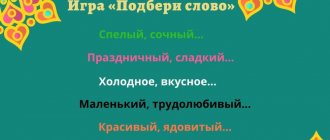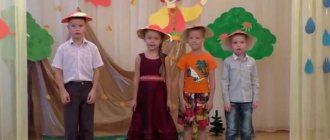Active gymnastics: games for developing speech using fine motor skills
Game aids:
- Butterflies made of colored paper
- Leaves of colored paper
- Pinwheel
- Cotton balls
- Paper boat
Games for children from 2 months:
- That's how different they are. Objects of various textures and shapes are placed in the child’s hand. The baby must grab the object and hold it for a while. This exercise develops not only motor skills, but also tactile sensations. It’s good if you comment on what is happening: “This ball is smooth,” “This hedgehog is prickly,” etc.
Games for children from 9 months
- Prefabricated nesting dolls. First you need to collect one doll, then gradually complicate the game; after 2 years it should be a triple matryoshka.
- Pyramids. First you need to use a classic pyramid, the size of the rings of which decreases towards the top.
- Trace along the outline. You need to make cards with images of objects known to the baby, for example, a house, a tree, a car, and paste over their outlines with velvet paper. The essence of the game: an adult guides the baby’s finger along the contour and names the object. Then the outline is covered with beads or peas and the game is repeated.
- Cups and spoons. The child uses a spoon to pour sugar or semolina from one cup to another. You can also transfer beans, peas or nuts by hand.
- Modeling from plasticine. You need to start with a cylinder, and over time complicate the tasks: a ball, a carrot, a snake.
During the games, do not forget to comment on your actions and explain to your child everything that you do.
Games for children from 1 year:
- Strong palms. The child squeezes rubber toys. The best thing is the rubber hedgehog: the needles act like a massager.
- Mosaic. First you need to lay out simple shapes: paths, flowers, squares, and then move on to more complex ones: houses, cars, Christmas trees.
- Constructor. The size of the parts and the complexity of the design depend on the age of the baby: you need to start with the largest parts and the simplest structures, for example, building a turret.
- Beads. The size of the beads also depends on the age of the child. First, instead of beads, you can use balls from pyramids with round parts and string them on a thick cord; then the size of the parts must be gradually reduced, moving on to real beads. For the exercise, medium-sized beads already strung are used. The goal is to teach the child to lay out the outlines of objects from beads. For example, you can lay out a circle, square, heart, spiral, etc.
- Laces. Since lacing has different contents, it makes sense to play with the lacing process - for example, ask the child to sew a dress for his mother (lace-button) or lace shoes (lace-boot).
- Magic tray. Sprinkle a thin layer of semolina onto a tray and run the child’s finger over the cereal. The child is then shown how to draw various shapes. At the age of 2 - 3 years, you can draw numbers and letters.
- Multi-colored clothespins. The essence of the game is to teach the child to independently attach clothespins, and to make the game interesting, you can do this according to a thematic principle: rays to the sun, needles to the hedgehog, rain to the cloud, grass to the ground. Of course, for this you first have to make preparations. This is a rather difficult task for a child. Don't try to achieve results right away. To begin, take the baby’s hands in yours and do the exercise with him.
- Cinderella. You need to mix white and red beans and ask your child to sort them by color.
- Funny pictures. Spread the plasticine evenly over a sheet of cardboard and show your child how to lay out drawings using peas.
- Counting sticks. Show your child how to use counting sticks to lay out different shapes. It is advisable that the counting sticks are not smooth, but ribbed: this serves as an additional massage for the fingers.
- Little sculptor. Dough modeling (dough recipe: 1 cup flour, 1/2 cup salt, a little water). The advantage of dough over plasticine in this case is that the crafts can subsequently be used as toys.
- Fasten the button. You will need two pieces of thick fabric. On one of them, sew three buttons of different diameters, in the second, cut loops of appropriate size. First, show your child how to fasten the buttons, commenting on your actions: “We insert the large button into the large buttonhole, the medium button into the middle one, and the small button into the small one.” Then take the child's hands in yours and repeat the exercise. After this, you can invite the baby to try to fasten the buttons on his own. Don’t insist if the baby doesn’t want to or if he can’t do it. This is a very difficult exercise and requires practice to perform successfully.
- Stencils. It is recommended to start with stencils for internal tracing (it is easier for a child to trace inside than outside) and with the simplest shapes (circle or square). Practical advice: you can buy ready-made stencils, but it is better to make them yourself. The fact is that most standard stencils are small in thickness, and it is inconvenient for a child to trace them, since the pencil keeps slipping off. Therefore, the stencils must be quite voluminous. A good solution is to cut them out of a piece of linoleum or a shoebox.
Finger Theater
Finger theater is an exciting game that:
- Stimulates the development of fine motor skills;
- Introduces the child to the following concepts of shape, color, size;
- Helps develop spatial perception (the concepts of “right”, “left”, “next to each other”, etc.);
- Develops imagination, memory, thinking and attention;
- Helps develop vocabulary and activates speech functions;
- Forms creative abilities and artistic skills;
- Introduces basic mathematical concepts.
For children aged 1 – 2 years (using the example of the fairy tale “Kolobok”):
- First, introduce your child to the characters in the fairy tale. Invite your child to look at and touch the figures. Then put each character on your finger in turn and describe it.
- Introduce your child to the name of each finger on his hand. For example, you can say this: “I have a Kolobok sitting on my index finger.”
- Then act out a fairy tale for your child. Place the characters on your fingers and cross your arms. Start telling the story, raising your fingers with the characters as the action progresses. For example, the fairy tale “Kolobok” can be told as follows. Thumbs up with Grandma character. Tell your child that today this hero will bake Kolobok. Rhythmically tap the heels of your palms against each other without releasing your fingers. At the same time, say: “Grandma is kneading the dough.” Using the same principle, play up the appearance of each character.
For children aged 2 – 4 years (using the example of the fairy tale “Kolobok”):
- Ask your child if he remembers the fairy tale “Kolobok”. Remind him if necessary.
- Then ask your child to place the characters on the table in the order they appear in the story. At the same time, ask to characterize each of them according to the principle: “Grandma is old, kind, caring; Kolobok is round, ruddy, mischievous,” etc.
- Ask your child questions about the fairy tale. For example: “Why did grandma decide to bake Kolobok? Why did he leave his grandmother and grandfather? Who did he meet on the way?
- Then act out a fairy tale in front of the little spectator using a finger theater.
- At the end, ask your child to act out a fairy tale in front of you using a finger theater. If necessary, prompt him.
Finger games for speech development
The essence of the finger motor skills lesson is to teach the child to use his fingers to depict some objects or living beings. In this case, all finger movements must be explained to the baby. This will help the child understand concepts such as “top”, “bottom”, “right”, “left”, etc. After the child learns how to do the exercises himself, you can try to act out scenes or short fairy tales, distributing the roles among yourself and your little actor (for example, a meeting between a hedgehog and a bunny in the forest). Here are some examples of such exercises.
- Finger game “Bunny”. The index and middle fingers are straightened, the rest are clenched into a fist. Little man. “Run” with your index and middle fingers on the table. Finger game “Hedgehog”. Clasp your hands, straighten the fingers of one hand and the thumb of the other. Cat. Connect the middle and ring fingers with the thumb, raise the index and little fingers up. Horned goat. The index and little fingers are straight, the thumb is on the bent ring and middle fingers. Butterfly. Cross your hands at the wrists and press your palms with the backs of your hands facing each other, fingers straight; palms with straight fingers make slight movements in the wrists - “butterfly flies.” Glasses. Fold the fingers of your right and left hands into rings and bring them to your eyes.
In addition to these examples, you yourself can come up with many interesting and entertaining exercises for your child to develop speech.
“Storytelling as a way to develop coherent speech in children of senior preschool age”
Authors:
Tolokonnikova Valeria Aleksandrovna, teacher-speech therapist of the first qualification category
Khokhlova Daria Andreevna, teacher-speech therapist of the first qualification category
MADO kindergarten No. 79 in Tyumen
Master class “Storytelling as a way to develop coherent speech in children of senior preschool age”
Goal: to increase the professional competence of preschool teachers in the development of coherent speech in children of senior preschool age, through the use of the “storytelling” technique.
Tasks:
- To introduce teachers to the “storytelling” technique and the advantages of its use in the development of coherent speech in preschoolers.
- To train teachers in practical techniques for using the “storytelling” technique in working with children to develop coherent speech.
Relevance:
The development of coherent speech is the central task of children's speech education. This is due, first of all, to its social significance and role in the formation of personality. Namely, in coherent speech the main, communicative, function of language and speech is realized. Coherent speech is the highest form of speech and mental activity, which determines the level of speech and mental development of the child.
Currently, educational practice has accumulated a sufficient number of methods, scientific works, and articles on the development of coherent speech in preschoolers. Many teachers successfully use techniques and technologies borrowed from other scientific fields in their work. The “storytelling” technique, borrowed from the field of marketing, interested us because it allows us to expand opportunities for the development and enrichment of speech, imagination and communication skills of children of senior preschool age.
Content:
Theoretical part.
The word “storytelling” translated from English sounds like “telling stories.” The “storytelling” technique is very multifaceted, multi-purpose, solving many teaching, developmental and educational problems. It was invented and successfully tested through personal experience by a person far from pedagogy, David Armstrong, the head of a major international corporation. This technique was intended for adults.
Based on the “storytelling” technique, several years ago in Europe they came up with the game “Story cubes”. These are 9 cubes, 54 pictures that immerse you in a world of fantasies, illusions and adventures. The original “Story cubes” can now be ordered on the Internet. But for children they are difficult, since only symbols and signs are depicted on the cubes. Taking the original version of the game as an idea, we decided to develop our own “Story Cubes”.
The goal of storytelling is to enrich oral speech and develop the ability of older preschoolers to write stories.
Tasks:
1. Enrich the active and passive vocabulary of preschoolers.
2. Clarify the use of grammatical forms of speech.
3. Develop communication skills of preschoolers.
At the initial stage of learning, a children's story can be very short - 1-2 sentences. At first, the task can be simplified, since not all children have sufficiently developed communication abilities. Therefore, you can make up stories one by one, the child throws the first die, and the teacher throws the next. This way, the adult will be able to guide and adjust the storyline in the right direction.
Children learn quite quickly. After 2-3 games they can freely compose a story, understanding how to interpret and connect pictures into a storyline, how to start and end a story.
Practical part.
Like every game, storytelling has its own rules. They are simple and easy for children to remember. To make it more interesting for children to play, you can invite them to turn into “STORY TELLERS”.
In this version of the game, from 1 to 9 children can participate. The first player rolls the dice and, depending on the picture that appears, begins to tell a fascinating story. Then, the next players choose and roll the dice and continue the story without losing the thread of the story.
When writing a story, you must follow the following structure:
1. Introduction.
You need to start the story in an interesting way; you can invite children to remember the beginning of fairy tales.
- Once upon a time, many years ago...
- In some kingdom, in some state...
- Once upon a time...
- Lived once…
- It happened in one town...
Then the “storytellers” describe the main character of the story, where does he live, what does he do?
2. The main part of the story.
The main storyline is described.
- What happened to the hero?
- Who did he meet or what did he find?
- What does he plan to do about it?
3. Conclusion.
- A solution to the problem appears.
- Short conclusion (summary of the story).
“Storytelling” is an interesting technique for composing fantasy stories and developing coherent speech. Also, this technique can be used in correctional and developmental work with children with speech disorders. You can enrich your vocabulary, grammatical structure of speech and compose a story using various lexical topics through storytelling.
To do this, children are invited to turn into “SCIENTISTS” and compose a scientific story. In this version of the game, mnemonic diagrams are used, which present an algorithm for composing a story, including: the beginning of the story, the middle and the end. Taking into account the program theme, the pictures on the cubes can be changed and new stories can be composed for each lexical topic. For example, a story on the lexical topic “Pets”.
When composing a story, a mnemonic diagram based on N.E. is used. Teremkova, which is divided into three parts (beginning, middle, end), each part of the story is indicated by its own color (beginning - blue, middle - yellow, end - green).
The child rolls the first blue die and names the animal whose image appears. Then, he selects an image on the second blue cube, guided by a mnemonic diagram (“What is the name of the animal’s house?”). The second “scientist” uses yellow cubes to tell the middle of the story, and the third “scientist” uses green cubes to finish the story.
This game has another option: children are invited to be “FANTASERS” and come up with funny stories about animals. The algorithm for composing the story remains the same, but now children roll the dice instead of choosing logically appropriate sides, and the result is a funny story about an animal.
The storytelling technique is widely used in speech correction. Storytelling can be used to automate sounds. For this, a set of cards with pictures is used, the name of which contains an automated sound at the beginning, in the middle or at the end of the word. When composing a story, the child will consolidate in speech the sound that requires automation and self-control. You can also choose a set of cards to differentiate sounds.
In this type of game, children develop another component of speech - phonemic hearing. By determining the position of sounds in words (beginning, middle, end), and arranging the cubes in the appropriate sequence, based on the position of the sound, a story is compiled.
If you increase the number of cubes in a set to 14, you can use it to correct violations of the syllabic structure of a word. The set of cards contains all 14 types of words according to A.K. Markova. Each cube is 6 words of each of the 14 syllable types.
“Storytelling” does not limit the imagination of teachers in creating games for children. Since the technique is multifaceted, using it in the development of coherent speech, we can develop and correct other components of the speech system.
Thus, we can highlight the following advantages of using the storytelling technique in working with children of senior preschool age:
- Increased interest in the task and, as a result, increased concentration;
- Expanding the stock of knowledge about the world around us;
- Development of all speech components;
- Development of higher mental functions;
- Development of children's communication skills.
Performance:
- Motivation for the conscious activity of all participants taking part in the master class;
- Increasing the level of theoretical and methodological training of participants;
- The readiness of teachers to develop their own transformative activities in the classroom;
- Reflection on the activities of teachers in the process of their own practice.
Bibliography:
1. Rusakova A.S. Keys to a child's soul. How to tell and compose stories and fairy tales. - M.: Obruch, 2015. -192 p.
2.Simmons A. Storytelling. How to harness the power of stories. - M.: Mann, Ivanov and Ferber, 2013. - 177 p.
3. Fedorova S. V., Barcheva A. A. Using storytelling techniques in working with preschool children // Young scientist. - 2021. - No. 16. - pp. 515-518.
“Evidence of publication in the media” Series A No. 0007224 - No. 0007225
We invite teachers of preschool education in the Tyumen region, Yamal-Nenets Autonomous Okrug and Khanty-Mansi Autonomous Okrug-Yugra to publish their teaching materials: - Pedagogical experience, original programs, teaching aids, presentations for classes, electronic games; — Personally developed notes and scenarios of educational activities, projects, master classes (including videos), forms of work with families and teachers.
Why is it profitable to publish with us?
1. “Kindergartens of the Tyumen Region” is an officially registered specialized media outlet at the federal level. 2. The activities of the editorial office are supported by the Department of Education and Science of the Tyumen Region 3. We issue a “Certificate of Publication” in the media. 4. The document has a unique number, is entered in the register, has the original seal of the editorial office of the online publication and signature. 5. “Certificate of publication” in the media is sent to the author in both paper and electronic versions.
Details >>>
Sample “Certificate of publication of author’s methodological material in the media.”pdf
Share






